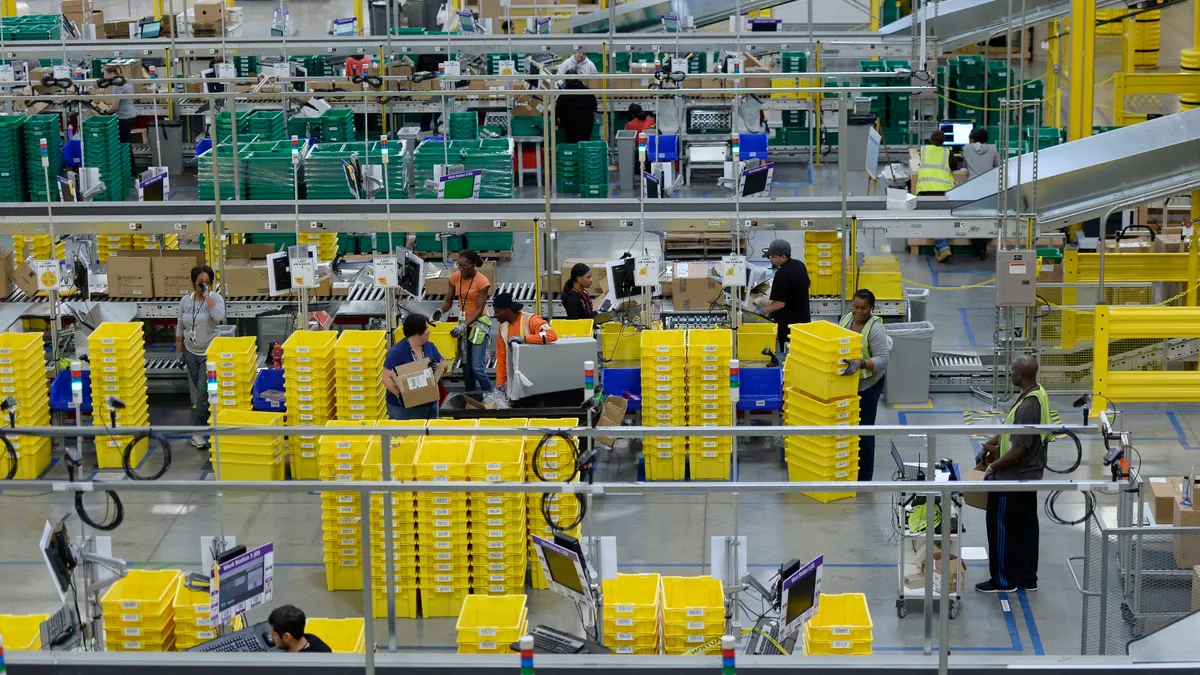As shipping containers clog the ports of Los Angeles and Long Beach, many importers are running into similar problems: There isn't enough warehouse space to store incoming freight.
This lack of capacity prevents many containers from advancing through an already congested supply chain. Stakeholders are attempting to provide relief in several ways, such as filling parking lots with drop trailers, securing warehouse space outside port markets or even diverting freight to the East Coast. It's often not enough for companies attempting to meet high demand without enough workers.
"As you're getting backed up, space becomes limited," said Piyush Golia, president of PCA Group, which handles distribution and logistics for beauty brands. "Space becomes limited, and now you're no longer efficient. It's a series of dominoes. If one falls, the rest keep falling."
Here are seven charts that outline the extent of warehouse capacity constraints near the San Pedro Bay ports and why this issue persists.
High demand creates low vacancy
The boom in online retail led to a surge in interest for space that could store inventory and fulfill e-commerce orders, including near major ports.
California's Inland Empire, a hotspot for warehousing and logistics firms close to the Port of Los Angeles and Port of Long Beach, saw a 0.7% vacancy rate in Q3, according to CBRE. That's the lowest rate the commercial real estate company has ever tracked for a market.
Inland Empire's available warehouse space plummets
"The bulk of demand is coming from overseas 3PLs, logistics and ecommerce tenants who service the Ports of Los Angeles and Long Beach," said a CBRE research report.
E-commerce-focused facilities have space requirements beyond what traditional warehouses need. They require capacity for returns processing and seasonal fluctuations in demand, according to a study from Deloitte. The focus on direct-to-consumer orders rather than palletized orders to stores also changes how space in the facility is used.
"Instead of having 100 guys driving forklifts that have pallets around, now you've got individuals that have to do a lot of picking and packing," Rich Thompson, international director of supply chain and logistics solutions at JLL, said in August.
Space is also limited in other markets near San Pedro Bay. According to data provided by Cushman & Wakefield, Q3 industrial real estate vacancy rates were low in Los Angeles (1.6%), Orange County (0.9%) and even further south in San Diego (1.9%).
Prices climb, forcing renters elsewhere
The Inland Empire's average asking lease rate reached an all-time high in Q3 after growing more than 50% YoY, according to CBRE.
Higher rates didn't stymie transactions in the quarter. At least five firms in the logistics and transportation sector, including DHL and XPO Logistics, secured industrial real estate spaces larger than 600,000 square feet, per CBRE.
Inland Empire renters accept higher prices
The combination of low vacancy and high rents near the ports is causing other companies to look for less-expensive space in inland markets, such as Phoenix or Salt Lake City, said Carolyn Salzer, Cushman & Wakefield's head of logistics and industrial research for the Americas, in an email.
Markets outside California rise as inexpensive options
Truckers wait at clogged warehouses
As companies scramble to find more warehouse space, the warehouses they do have are packed with orders.
"There is a linear relationship between the volume getting pushed into these warehouses and the dwell time increasing," said Ryan Closser, director of network enablement at FourKites.
The average truckload dwell time in Los Angeles climbed from 75 minutes on Sept. 1 to about 90 minutes in November, according to data provided by FourKites.
In early November, California as a whole saw dwell times climb and truck movement decrease. According to FourKites' website, this could mean operational issues or labor shortages in the facilities the trucks service.
Dwell times climb as truckers encounter congested warehouses
Warehouses struggle to staff operations
Labor is necessary to get freight off the trucks, into the warehouses and eventually loaded onto outbound trailers.
"There's only so many robots you can buy," said Dale Young, vice president of warehousing and distribution at World Distribution Services. "You're still going to need people and buildings, and you're going to have to give them a career."
Despite warehouse employment continuing to climb this year, companies like Amazon and FedEx still haven't been able to hire enough people amid heightened demand for their services.
The Inland Empire has an even more pronounced need for warehouse workers. Before the pandemic accelerated e-commerce activity, California projected job openings for warehouse workers in the Riverside-San Bernardino-Ontario MSA through 2028 to surpass all other area occupations.
Inland Empire warehouse workers to remain in high demand
Construction issues slow new builds
Additional warehouse capacity is in the construction pipeline, although not as much as in previous years.
More than 21.3 million square feet of industrial real estate space was under construction in the Inland Empire as of Q3, a market that has 588 million square feet of industrial space in total, according to CBRE. More square footage was under construction in Q3 of 2018 (25.8 million) and 2019 (27.1 million).
It also may take a while for new buildings to accept inventory, as construction completions are slowing.
"The availability of warehouse space is impacted by construction delays throughout the Inland Empire due to increased costs in materials and lead times to receive these materials," CBRE said. "These issues in construction materials are causing 12-to-18-month delays on construction projects."
A lack of warehouse capacity can ripple into companies' ability to fulfill orders. Executives of manufacturing company Atkore said on a November earnings call that distributors won't order additional supply despite high demand, as their products are large in size and it's difficult to find available space at warehouses and shipping terminals.
Inland Empire industrial real estate completions dwindle
Demand isn't easing
The heightened import activity that exposed weaknesses in the U.S. supply chain and contributed to a greater need for warehousing space and workers hasn't subsided. In September, the ports of Los Angeles and Long Beach handled 10.7% more imported loaded TEUs combined than they did two years prior.
Public and private stakeholders are tackling congestion issues in myriad ways, like finding additional land to store containers before they reach warehouses and mulling the implementation of container dwell fees to clear terminals. But matching the supply of warehouse capacity and labor to demand will take time.
"You can't just click the button and bring 15% more labor into the warehouse to unload," Closser said. "You can't just increase the floor space by 15% of the warehouse, right? So it's a balancing act here of how much can we take in, how much can we push out, and right now, that's a huge chokepoint within the SoCal supply chain."
Closser added that space constraints aren't going to improve for at least the rest of 2021, as the various issues pestering supply chains for the past 18 months "are increasing in complexity."
West Coast imports climb during pandemic
Editor's note: This story was first published in our Logistics Weekly newsletter. Sign up here.























